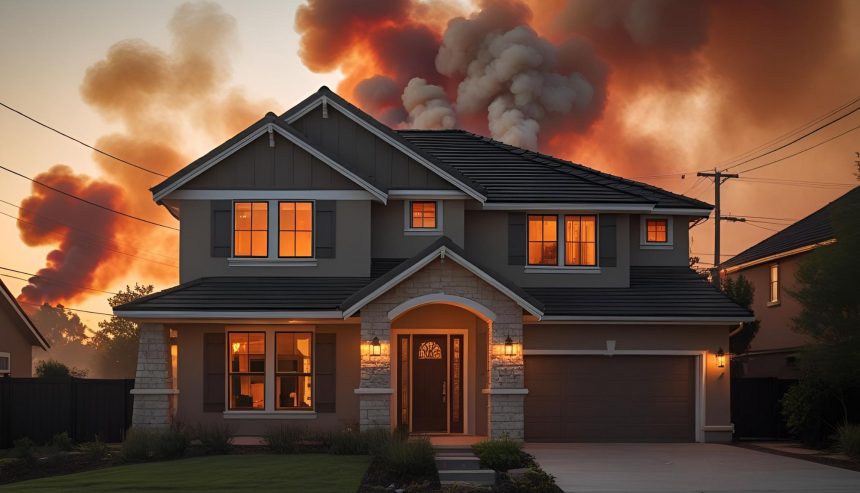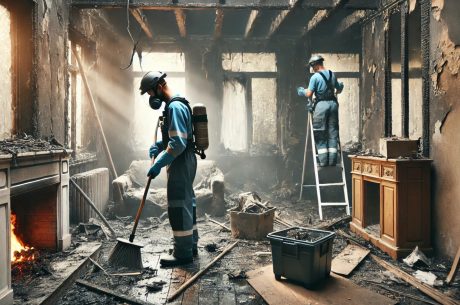Table of Contents
How to Protect Your Home from Smoke Damage
Wildfires have become increasingly common in recent years, fueled by climate change, prolonged droughts, and extreme heat. While the flames themselves are devastating, the smoke they produce can travel hundreds—even thousands—of miles, affecting air quality far beyond the fire’s origin. Smoke intrusion into homes poses serious health risks and can cause lingering odors, soot damage, and respiratory problems.
In this blog post, we’ll explore how wildfire smoke enters your home, the dangers it presents, and the best strategies to protect your indoor air quality and property.
How Does Wildfire Smoke Enter Your Home?
Wildfire smoke consists of a dangerous mix of gases and fine particles from burning vegetation, buildings, and other materials. These microscopic particles (PM2.5) can easily infiltrate homes through:
- Open Doors and Windows – The simplest entry point for smoke. Even brief openings can allow significant smoke inside.
- Ventilation Systems – HVAC systems, especially those with outdoor air intake, can pull smoke particles indoors.
- Cracks and Gaps – Poorly sealed windows, doors, and foundations let smoke seep in.
- Attics and Crawl Spaces – Unsealed vents or gaps in roofing can allow smoke to enter upper levels.
- Fireplaces and Chimneys – Without proper dampers, smoke can flow backward into your home.
Once inside, smoke particles settle on surfaces, fabrics, and even inside walls, leading to persistent odors and potential long-term damage.
Health Risks of Wildfire Smoke Exposure
Breathing in wildfire smoke can cause immediate and long-term health effects, particularly for vulnerable groups such as children, the elderly, and those with respiratory or cardiovascular conditions. Common symptoms include:
- Short-term effects: Coughing, sore throat, irritated sinuses, headaches, and difficulty breathing.
- Long-term effects: Increased risk of asthma, bronchitis, and heart disease due to prolonged exposure to fine particulate matter.
Protecting your home from smoke intrusion is not just about comfort—it’s a critical step in safeguarding your family’s health.
How to Protect Your Home from Wildfire Smoke
1. Seal Your Home
Preventing smoke from entering is the first line of defense.
- Close windows and doors – Keep them shut as much as possible.
- Use weather stripping – Seal gaps around windows and doors to block smoke.
- Cover attic and crawl space vents – Temporarily seal them with plywood or tape during heavy smoke events.
- Close the fireplace damper – Prevent backdrafts of smoky air.
2. Improve Indoor Air Quality
Even with sealed homes, some smoke will get inside. Use these methods to filter the air:
- Run an air purifier – Choose a HEPA filter model to capture fine particles.
- Upgrade HVAC filters – Use MERV 13 or higher filters in your central air system.
- Avoid activities that pollute indoor air – Don’t burn candles, smoke, or fry foods, which add more particles to the air.
3. Create a Clean Air Room
Designate one room (preferably a bedroom) as a “clean air space” by:
- Using a portable HEPA air purifier.
- Keeping doors and windows tightly closed.
- Adding a box fan with a MERV 13 filter for extra filtration.
4. Monitor Air Quality
Stay informed about local air quality using resources like:
- AirNow.gov (U.S. EPA’s air quality tracker)
- PurpleAir (Real-time community air quality sensors)
- Weather apps (Many include AQI alerts)
When the Air Quality Index (AQI) exceeds 150, take extra precautions by limiting outdoor exposure and running air purifiers continuously.
5. Clean and Deodorize After Smoke Exposure
If smoke has already entered your home, take steps to remove lingering particles and odors:
- Wipe surfaces – Use microfiber cloths and mild cleaners to remove soot.
- Wash fabrics – Curtains, bedding, and upholstery can trap smoke particles.
- Replace HVAC filters – After smoke events, filters may be clogged with particles.
- Use activated charcoal or baking soda – These help absorb stubborn smoke odors.
6. Prepare for Future Wildfire Seasons
Proactive measures can minimize smoke damage in the long run:
- Install high-quality air filters in your HVAC system year-round.
- Consider an ERV (Energy Recovery Ventilator) – Provides fresh air filtration without letting smoke in.
- Inspect and seal your home’s envelope – Professional energy audits can identify leaks.

Final Thoughts
Hoarding-related biohazard cleanup is a challenging but necessary process to restore safety and dignity to affected individuals. Due to the severe health risks involved—including smoke damage—professional remediation is crucial. Beyond the physical cleanup, addressing the psychological aspects of hoarding disorder is essential for long-term recovery.
If you or someone you know is struggling with hoarding (especially after fire incidents causing smoke damage), seek help from biohazard cleanup specialists and mental health professionals. A compassionate, structured approach can make all the difference in transforming a hazardous environment into a safe, livable space.
For more information on biohazard cleanup services (including smoke damage restoration) or hoarding support resources, contact a local remediation company or mental health organization today.
Call PuroClean of Auburn on 207-531-1200 for Professional Fire Damage Restoration in Maine
Recovering from a house fire is a challenging process, but you don’t have to go through it alone. PuroClean of Auburn is here to help, providing expert fire damage cleanup, smoke removal, and water mitigation services.
📞 Call us 24/7 at 207-531-1200 for immediate assistance. Our experienced team is ready to restore your home and help you get back to normal as quickly as possible.
Have you experienced wildfire smoke in your home? Share your tips and experiences in the comments below!




 PuroClean of Auburn
PuroClean of Auburn